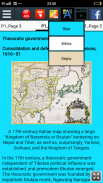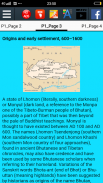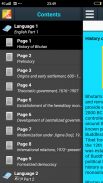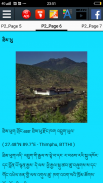










History of Bhutan

Descrizione di History of Bhutan
Bhutan's early history is steeped in mythology and remains obscure. Some of the structures provide evidence that Bhutan existed as early as 2000 BC. According to a legend it was ruled or controlled by a Cooch-Behar king, Sangaldip, around the 7th century BC,[1] but not much is known prior to the introduction of Tibetan Buddhism in the 9th century, when turmoil in Tibet forced many monks to flee to Bhutan. In the 12th century, the Drukpa Kagyupa school was established and remains the dominant form of Buddhism in Bhutan today. The country's political history is intimately tied to its religious history and relations among the various monastic schools and monasteries.[2]
Bhutan is one of only a few countries which have been independent throughout their history, never conquered, occupied, or governed by an outside power (notwithstanding occasional nominal tributary status). Although there has been speculation that it was under the Kamarupa Kingdom or the Tibetan Empire in the 7th to 9th centuries, firm evidence is lacking. From the time historical records are clear, Bhutan has continuously and successfully defended its sovereignty.[3]
The consolidation of Bhutan occurred in 1616 when Ngawanag Namgyal, a lama from western Tibet known as the Zhabdrung Rinpoche, defeated three Tibetan invasions, subjugated rival religious schools, codified the Tsa Yig, an intricate and comprehensive system of law, and established himself as ruler over a system of ecclesiastical and civil administrators. After his death, infighting and civil war eroded the power of the Zhabdrung for the next 200 years. In 1885 Ugyen Wangchuck was able to consolidate power, and began cultivating closer ties with the British in the subcontinant.[2]
In 1907, Ugyen Wangchuck was elected as the hereditary ruler of Bhutan, crowned on December 17, 1907, and installed as the head of state, the Druk Gyalpo (Dragon King). In 1910, King Ugyen and the British signed the Treaty of Punakha which provided that British India would not interfere in the internal affairs of Bhutan if the country accepted external advice in its external relations. When Ugyen Wangchuck died in 1926, his son Jigme Wangchuck became ruler, and when India gained independence in 1947, the new Indian Government recognized Bhutan as an independent country. In 1949 India and Bhutan signed the Treaty of Peace and Friendship, which provided that India would not interfere in Bhutan's internal affairs, but would guide its foreign policy. Succeeded in 1952 by his son Jigme Dorji Wangchuck, Bhutan began to slowly emerge from its isolation and began a program of planned development. The National Assembly of Bhutan, the Royal Bhutanese Army, and the Royal Court of Justice were established, along with a new code of law.[2] Bhutan became a member of the United Nations in 1971.
In 1972, Jigme Singye Wangchuck ascended the throne at age 16.[4] He emphasized modern education, decentralization of governance, the development of hydroelectricity and tourism and improvements in rural developments. He was perhaps best known internationally for his overarching development philosophy of "gross national happiness." It recognizes that there are many dimensions to development and that economic goals alone are not sufficient. Satisfied with Bhutan's transitioning democratization process, he abdicated in December 2006 rather than wait until the promulgation of the new constitution in 2008. His son, Jigme Khesar Namgyel Wangchuck, became King upon his abdication.[2]
storia remota del Bhutan è intriso di mitologia e rimane oscuro. Alcune delle strutture forniscono la prova che il Bhutan esisteva già nel 2000 aC. Secondo una leggenda fu governata o controllato da un re Cooch-Behar, Sangaldip, intorno al 7 ° secolo aC, [1], ma non si sa molto prima dell'introduzione del buddhismo tibetano nel 9 ° secolo, quando disordini in Tibet ha costretto molti monaci a fuggire in Bhutan. Nel 12 ° secolo, la scuola Drukpa Kagyupa è stato stabilito e rimane la forma dominante del buddismo in Bhutan oggi. storia politica del paese è strettamente legata alla sua storia religiosa e le relazioni tra le varie scuole monastiche e monasteri. [2]
Il Bhutan è uno dei pochi paesi che sono stati indipendenti nel corso della loro storia, mai conquistata, occupato, o governato da una potenza esterna (nonostante occasionali stato nominale tributario). Anche se ci sono state speculazioni che era sotto il Kamarupa Unito o l'impero tibetano in 7 al 9 ° secolo, prova certa è carente. Dal momento in documenti storici sono chiari, il Bhutan ha continuamente e ha difeso con successo la sua sovranità. [3]
Il consolidamento del Bhutan si è verificato nel 1616, quando Ngawanag Namgyal, un lama dal Tibet occidentale conosciuto come lo Zhabdrung Rinpoche, ha sconfitto tre invasioni tibetane, soggiogato scuole religiose rivali, ha codificato la Tsa Yig, un intricato sistema e completa del diritto, e si affermò come righello su un sistema di amministratori ecclesiastiche e civili. Dopo la sua morte, lotte interne e la guerra civile eroso il potere del Zhabdrung per i prossimi 200 anni. Nel 1885 Ugyen Wangchuck è stato in grado di consolidare il potere, e ha iniziato a coltivare legami più stretti con gli inglesi nel subcontinant. [2]
Nel 1907, Ugyen Wangchuck è stato eletto come il sovrano ereditario del Bhutan, incoronata il 17 dicembre 1907, e installato come il capo dello Stato, il Druk Gyalpo (Re Drago). Nel 1910, il re Ugyen e gli inglesi hanno firmato il trattato di Punakha che prevedeva che la British India non avrebbe interferito negli affari interni del Bhutan se il paese ha accettato consulenze esterne nelle sue relazioni esterne. Quando Ugyen Wangchuck morì nel 1926, suo figlio Jigme Wangchuck è diventato sovrano, e quando l'India ottenne l'indipendenza nel 1947, il nuovo governo indiano ha riconosciuto il Bhutan come paese indipendente. Nel 1949 l'India e Bhutan hanno firmato il Trattato di Pace e Amicizia, che prevedeva che l'India non avrebbe interferito negli affari interni del Bhutan, ma avrebbe guidato la sua politica estera. Riuscito nel 1952 dal figlio Jigme Dorji Wangchuck, il Bhutan ha cominciato ad emergere lentamente dal suo isolamento e ha iniziato un programma di sviluppo pianificato. L'Assemblea nazionale del Bhutan, il Royal bhutanese Esercito, e la Corte Reale di Giustizia sono stati stabiliti, insieme a un nuovo codice di diritto. [2] Il Bhutan è diventato un membro delle Nazioni Unite nel 1971.
Nel 1972, Jigme Singye Wangchuck salì al trono all'età di 16 anni [4] Egli ha sottolineato l'educazione moderna, il decentramento della governance, lo sviluppo di energia idroelettrica e del turismo e miglioramenti negli sviluppi rurali. E 'stato forse il più noto a livello internazionale per la sua filosofia di sviluppo globale di "felicità interna lorda". Si riconosce che ci sono molte dimensioni per lo sviluppo e che gli obiettivi economici da soli non sono sufficienti. Soddisfatto processo di democratizzazione transizione del Bhutan, abdicò nel dicembre 2006, piuttosto che aspettare fino alla promulgazione della nuova costituzione nel 2008. Suo figlio, Jigme Khesar Namgyel Wangchuck, divenne re al suo abdicazione. [2]

























